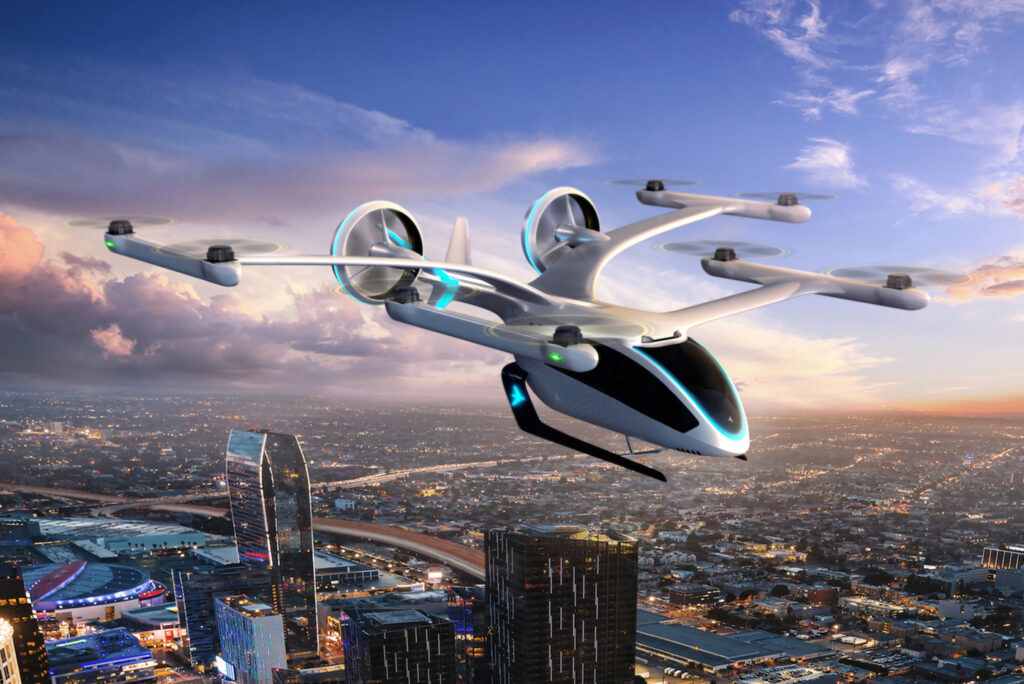
There was a time when people used to say – sky is the limit. Not anymore. In 1940, automaker Henry Ford made a mockery of himself when he said, “Mark my words: a combination of airplane and motorcar is coming.” People laughed at him, but now, decades later the concept behind autonomous vehicles and “flying cars” is no longer something straight out of sci-fi comics but a reality in the skies above our cities.
From solar airplanes to unmanned helicopters – the need to travel swiftly and avoid traffic jams on roads in densely populated cities has introduced new possibilities for urban air mobility (UAM). In a way one could say that the world is approaching a new era of electrified/hybrid aircraft propulsion. UAM is increasingly seen as the future for affordable, rapid and sustainable intercity travel, and some companies are looking to launch their services as early as the end of 2022.
One of the most recent breakthroughs is eVTOL – electric-powered aerial vehicles that can take-off, land, hover and move in any direction. The electric vertical take-off and landing vehicles (eVTOLs) have several advantages over the ground transport vehicles and may eventually prove to be quieter, safer, more affordable and more environmentally friendly than traditional helicopters.
Like conventional helicopters, VTOL aircraft offer a reduced logistical burden as they are able to operate without a runway and with minimal ground infrastructures to collect payload in remote locations.
According to a BluePaper released by Morgan Stanley Research autonomous urban flying machines may no longer be the stuff of comic books and eVTOL could become the future of passenger travel, military and defense applications, and freight and package transportation.
Globally, the market for eVTOL aircraft is growing rapidly and is predicted to be around $4,222.4 million by 2033 and $1.5 trillion by 2040. The growth of this market is mainly driven by the growing need for green energy and noise-free alternative mode of transport and the increasing use of eVTOL aircraft for passenger and cargo mobility.
eVTOL Advantage:
According to experts 68% of the predicted 9.8 billion world population will live in urban areas by 2050. This urbanization will lead to an ever-increasing number of people seeking opportunity in cities. As existing cities continue to grow and accommodate their rising populations, their need for mobility will also increase. This will also lead to an increase in the number of daily car rides, as well as the load carried by public transport.
Every year people all over the world spend dozens of hours stuck in traffic. Cities coping with this increasing organic growth are reaching the limits of what mobility services they can offer. More often than not, new roads cannot be built, subway frequency cannot be increased and new railroad tunnels and tracks take too long to build and are overly expensive. At the same time, improving mobility is paramount to the economic productivity and the quality of life in cities. Offering individual and sustainable transportation options is necessary to respond to these challenges.
The state of the market
The market for eVTOL worldwide has grown dramatically over the last four years. According to a recent report from the Vertical Flight Society (VFS) its Electric VTOL directory has listed 600 concepts from 350 companies around the world.
Some of the key players in the global eVTOL market include Boeing, Airbus, Airspace Experience Technologies, Aurora Flight Sciences, Bell Helicopter, EHANG, Embraer, Honda, Toyota, Hyundai, Kitty Hawk, Lilium, Neva Aerospace, Opener, Pipistrel, Volocopter, and Workhorse Group.
Already more than one hundred fifty companies are in the process of developing prototypes. Amazon, Google, Apple, Facebook the Big Four technology companies are also moving into the eVTOL space placing vast venture capital and highly-talented human capital into these efforts. Venture capitalists have invested more than one billion dollars in eVTOL aircraft startups. Many well-known CEOs are supporting eVTOL projects. For instance Google’s co-founder has invested $100 million in a “flying car” concept.
Most of the major aircraft companies are directly developing their own eVTOL aircraft or their subsidiaries doing so. For instance PAL-V has developed the world’s first flying car production model. Lilium has developed a two- and a five-seater air taxi. Kitty Hawk is testing Cora an air taxi and Flyer a hoverbike while E-Hang (China) claims to have manufactured quadrotor UAVs and tested it with humans on board. Likewise Uber Elevate is coordinating the development eVTOL aircraft and their operations.
Whether full-electric (relying solely on batteries) or hybrid-electric (relying on a combination of batteries, fuel-powered engines, and generators), eVTOLs are also expected to generate less noise and air pollution than conventional aircraft with similar payloads.
An Uber Elevate white paper “Fast-Forwarding to a Future of On-Demand Urban Air Transportation,” elaborates plans for an on-demand urban air transportation service using thousands of eVTOL aircraft—autonomously piloted—with very low direct operating costs, low noise and zero “tailpipe” emissions.
Applications: The applications of the eVTOL include the following:
Already, a number of companies in different parts of the globe are working on air taxi projects. Air taxis are ideal for congested locations, as they allow people to commute between two points in less time. In remote areas where passenger demand exceeds the current transportation system’s capacity, air taxis are nothing less than a divine blessing. Unlike cars and buses that move on ground, air taxis do not require tracks or roads.
Pipistrel, an Uber Elevate partner, is working on the Pipistrel 801 – a 5 seats air taxi. The Pipistrel eVTOL concept uses dedicated propulsion systems for cruising and vertical lift and is part of a proposed family of aircraft capable of carrying between two and six people. The Pipistrel eVTOL is being designed to travel longer distances at higher speeds at a lower operating costs using a new integrated vertical lift system. According to aviation experts Pipistrel is not trying to reinvent the helicopter by giving the vehicle many rotors, but is rather embracing dedicated propulsion solutions for cruise and vertical lift. Pairing an integrated vertical lift system with highly aerodynamic wings may result in a new class of eVTOL.
Another big player in the eVTOL and heavy-lift drone segment is Volocopter, which plans to introduce air mobility to your life by introducing an air taxi service called VoloCity, based on the Volocopter 2X. Volocopter is the world’s first and only electric multicopter company with Design Organisation Approval (DOA) from the European Union Aviation Safety Agency (EASA).
Air Ambulance and casualty evacuation
eVTOLs may also prove to be the safest and most efficient means of transport for casualty evacuation and transporting relief material in the event of a natural disaster even in far-flung areas where ground transport cannot reach. The eVTOLs can also be used for fire-fighting in tall buildings and forest fires. Since eVTOLs can move faster in congested areas and get to the scene of an incident much faster they can be extremely useful for police and medical transport. In other words eVTOLs can be lifesavers because of their ability to provide a more flexible and direct journey.
Medical assistance (EMS)
JumpAero is working on a small, one-seater eVTOL aircraft for rapid deployment of emergency services. This vehicle is not meant to be a replacement for land vehicles or helicopters, but a new tool that is faster than the others. Likewise the Canadian Air Mobility consortium is exploring options for direct hospital-to-hospital transportation of patients, organs and drugs.
Cargo Delivery:
Another area where eVTOLs can prove to be far more efficient and faster than ground vehicles is cargo deliveries to parcel deliveries. A quicker delivery will result in a better customer experience and benefit businesses. eVTOLs can also be utilized to carry critical supplies such as vaccines, masks, and other medical equipment, in the event of an emergency.
According to industry reports companies like Zipline have shown interest in eVTOL aircraft for civil & commercial applications like transportation of medical supplies and aerial photography. Likewise retail and logistics companies are looking to use electric UAVs to supply medicines as well as transport organs and blood across cities. Alphabet, a Google-owned company has a fleet of drones which fly up to 100 km and carry up to 1.5 kg. Amazon Air and UPS are two other companies using drone delivery, while Wingcopter is collaborating with UNICEF to deliver vaccines.
Armed Forces:
Besides being a cheaper, greener transportation alternative the eVTOL aircraft can have a wide range of applications for personnel transportation, surveillance, humanitarian response, and reconnaissance in armed forces. The U.S. Department of Defense, for example, is currently evaluating eVTOLs for small-scale reconnaissance tasks using technology similar to that in commercial camera drones.
On August 20, 2020, United States Air Force (USAF) held a demonstration flight of an eVTOL at Camp Mabry in Texas. It was the first time that a manned eVTOL aircraft took flight under the USAF Agility Prime program.






Add comment